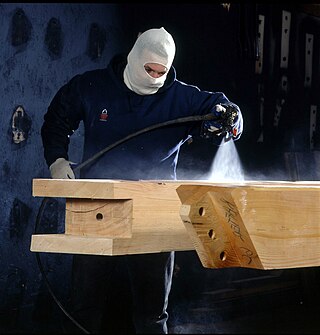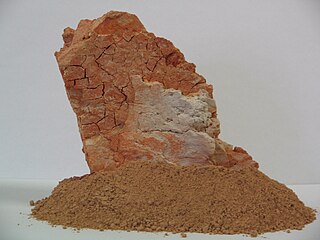
Shellac is a resin secreted by the female lac bug on trees in the forests of India and Thailand. Chemically, it is mainly composed of aleuritic acid, jalaric acid, shellolic acid, and other natural waxes. It is processed and sold as dry flakes and dissolved in alcohol to make liquid shellac, which is used as a brush-on colorant, food glaze and wood finish. Shellac functions as a tough natural primer, sanding sealant, tannin-blocker, odour-blocker, stain, and high-gloss varnish. Shellac was once used in electrical applications as it possesses good insulation qualities and seals out moisture. Phonograph and 78 rpm gramophone records were made of shellac until they were replaced by vinyl long-playing records from 1948 onwards.

A manicure is a mostly cosmetic beauty treatment for the fingernails and hands performed at home or in a nail salon. A manicure usually consists of filing and shaping the free edge of nails, pushing and clipping any nonliving tissue, treatments with various liquids, massage of the hand, and the application of fingernail polish. When the same is applied to the toenails and feet, the treatment is referred to as a pedicure. Together, the treatments may be known as a mani-pedi. Most nail polish can stay on nails for 2–3 days before another manicure is required for maintenance, if there is no damage done to it.

Varnish is a clear transparent hard protective coating or film. It is not to be confused with wood stain. It usually has a yellowish shade due to the manufacturing process and materials used, but it may also be pigmented as desired. It is sold commercially in various shades.

Lacquer is a type of hard and usually shiny coating or finish applied to materials such as wood or metal. It is most often made from resin extracted from trees and waxes and has been in use since antiquity.
An abrasive is a material, often a mineral, that is used to shape or finish a workpiece through rubbing which leads to part of the workpiece being worn away by friction. While finishing a material often means polishing it to gain a smooth, reflective surface, the process can also involve roughening as in satin, matte or beaded finishes. In short, the ceramics which are used to cut, grind and polish other softer materials are known as abrasives.

Patent leather is a type of coated leather that has a high-gloss finish.

Sandpaper, also known as glasspaper or as coated abrasive, is a type of material that consists of sheets of paper or cloth with an abrasive substance glued to one face. In the modern manufacture of these products, sand and glass have been replaced by other abrasives such as aluminium oxide or silicon carbide. It is common to use the name of the abrasive when describing the paper, e.g. "aluminium oxide paper", or "silicon carbide paper".

Wood stain "Rosewood color" is a type of paint used to colour wood comprising colourants dissolved and/or suspended in a vehicle or solvent. Pigments and/or dyes are largely used as colourants in most stains.

Wood finishing refers to the process of refining or protecting a wooden surface, especially in the production of furniture where typically it represents between 5 and 30% of manufacturing costs.

Rotten stone, sometimes spelled as rottenstone, also known as tripoli, is fine powdered porous rock used as a polishing abrasive for metalsmithing and in woodworking. It is usually weathered limestone mixed with diatomaceous, amorphous, or crystalline silica. It has similar applications to pumice, but it is generally sold as a finer powder and used for a more glossy polish after an initial treatment with coarser pumice powder. Tripoli particles are rounded rather than sharp, making it a milder abrasive.

Knife making is the process of manufacturing a knife by any one or a combination of processes: stock removal, forging to shape, welded lamination or investment cast. Typical metals used come from the carbon steel, tool, or stainless steel families. Primitive knives have been made from bronze, copper, brass, iron, obsidian, and flint.

Wood putty, also called plastic wood, is a substance used to fill imperfections, such as nail holes, in wood prior to finishing. It is often composed of wood dust combined with a binder that dries and a diluent (thinner), and, sometimes, pigment. Pore fillers used for large flat surfaces such as floors or table tops generally contain silica instead of or in addition to wood dust. Pores can also be filled using multiple coats of the final finish rather than a pore filler.

Buffing are finishing processes for smoothing a workpiece's surface using an abrasive and a work wheel or a leather strop. Technically, polishing refers to processes that uses an abrasive that is glued to the work wheel, while buffing uses a loose abrasive applied to the work wheel. Polishing is a more aggressive process, while buffing is less harsh, which leads to a smoother, brighter finish. A common misconception is that a polished surface has a mirror-bright finish, however, most mirror-bright finishes are actually buffed.

Wood flooring is any product manufactured from timber that is designed for use as flooring, either structural or aesthetic. Wood is a common choice as a flooring material and can come in various styles, colors, cuts, and species. Bamboo flooring is often considered a form of wood flooring, although it is made from bamboo rather than timber.

Danish oil is a wood finishing oil, often made of tung oil or polymerized linseed oil. Because there is no defined formulation, its composition varies among manufacturers.

Floor sanding is the process of removing the top surfaces of a wooden floor by sanding with abrasive materials.
A grain filler is a woodworking product that is used to achieve a smooth-textured wood finish by filling pores in the wood grain. It is used particularly on open grained woods such as oak, mahogany and walnut where building up multiple layers of standard wood finish is ineffective or impractical.

Tung oil or China wood oil is a drying oil obtained by pressing the seed from the nut of the tung tree. Tung oil hardens upon exposure to air, and the resulting coating is transparent and has a deep, almost wet look. Used mostly for finishing and protecting wood, after numerous coats, the finish can even look plastic-like. Related drying oils include linseed, safflower, poppy, and soybean oils. Raw tung oil tends to dry to a fine, wrinkled finish ; this property was used to make wrinkle finishes, usually by adding excess cobalt drier. To prevent wrinkling, the oil is heated to gas-proof it.

The conservation and restoration of silver objects is an activity dedicated to the preservation and protection of objects of historical and personal value made from silver. When applied to cultural heritage this activity is generally undertaken by a conservator-restorer.

Lacquer painting is a form of painting with lacquer which was practised in East Asia for decoration on lacquerware, and found its way to Europe and the Western World both via Persia and the Middle East and by direct contact with Continental Asia. The artistic form was revived and developed as a distinct genre of fine art painting by Vietnamese artists in the 1930s; the genre is known in Vietnamese as "sơn mài."


















